Click on images to enlarge

infestation amongst other weeds (Photo: Sheldon Navie)

habit (Photo: Forest and Kim Starr, USGS)
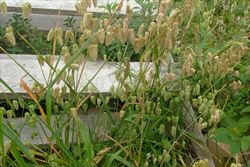
habit (Photo: Sheldon Navie)

stem, leaf sheath and base of leaf blade (Photo: Sheldon Navie)

leaf and young seed-head (Photo: Sheldon Navie)
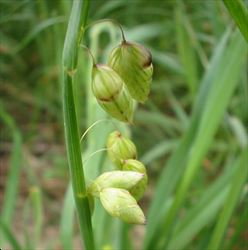
close-up of young flower spikelets (Photo: Sheldon Navie)
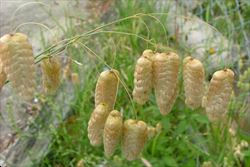
seed-head with nodding flower spikelets (Photo: Sheldon Navie)
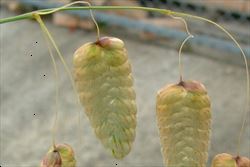
close-up of flower spikelets borne on very slender stalks (Photo: Sheldon Navie)

flower spikelets breaking up at maturity (Photo: Sheldon Navie)
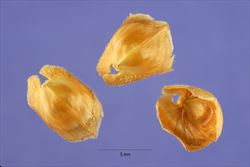
close-up of seeds (Photo: Steve Hurst at USDA PLANTS Database)

habit with young seed-heads (Photo: Sheldon Navie)
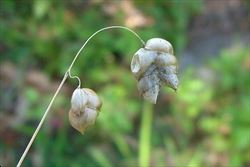
close-up of old flower spikelets breaking up at maturity (Photo: Sheldon Navie)
Scientific Name
Briza maxima L.
Synonyms
Briza major Presl
Family
Gramineae (South Australia)Poaceae (Queensland, New South Wales, the ACT, Victoria, Tasmania, Western Australia and the Northern Territory)
Common Names
big quaking grass, big quakinggrass, blowfly grass, broncho grass, fairy bells, giant shivery grass, great quaking grass, lady's heart grass, large fairy bells, large quaking grass, large quaking-grass, quaking grass, quaking-grass, quivering grass, shaky grass, shell grass
Origin
Native to northern Africa (i.e. northern Algeria, northern Libya, Morocco and Tunisia), southern Europe (i.e. Portugal, Spain, France, Albania, Bulgaria, Greece, Italy and Yugoslavia) and western Asia.
Cultivation
Quaking grass (Briza maxima) has been grown as a garden ornamental and for dried flower arrangements, though it is not very common in cultivation any more.
Naturalised Distribution
This species is widely naturalised in the southern and central parts of Australia (i.e. in south-eastern and central Queensland, in eastern and southern New South Wales, throughout Victoria, Tasmania and the ACT, in many parts of South Australia, in the southern parts of the Northern Territory and in the south-western and western parts of Western Australia). Also naturalised on Lord Howe Island and Norfolk Island.
Widely naturalised in other parts of the world (e.g. in the UK, Asia, New Zealand, USA, Central America, South America and Hawaii).
Habitat
A weed of gardens, footpaths, disturbed sites, waste areas, roadsides, railway lines, grasslands, heathlands, open forests, riparian habitats and coastal habitats in temperate, sub-tropical and semi-arid regions.
Habit
A short-lived (i.e. annual), tufted grass with upright (i.e. erect or ascending) stems growing 10-65 cm tall.
Distinguishing Features
-
a short-lived tufted grass with upright stems growing 10-65 cm tall.
-
where the leaf sheath meets the leaf blade there is a small membranous structure 2-5 mm long.
-
its seed-head is a drooping open panicle with 3-12 large flower spikelets.
-
these flower spikelets (7-25 mm long and 6-15 mm wide) have several to numerous (3-20) tiny florets.
-
the tiny florets break apart separately at maturity.
Stems and Leaves
Its stems are usually not branched and are hairless (i.e. glabrous). They are also somewhat hollow in the sections between the joints (i.e. internodes).
The leaves consist of a leaf sheath that partially encloses the stem and a spreading leaf blade. Leaves are tufted together at the base of the plant and alternately arranged along the stems. Where the leaf sheath meets the leaf blade there is a small membranous structure (i.e. membranous ligule) 2-5 mm long. The long and narrow (i.e. linear) leaf blades are flat (2-20 cm long and 1-8 mm wide) and mostly hairless (i.e. glabrous).
Flowers and Fruit
The seed-head (i.e. inflorescence) is a branched and spreading open panicle (2-10 cm long) with drooping branches. However, it only contains 3-12 large flower spikelets. These flower spikelets (7-25 mm long and 6-15 mm wide) are also drooping in nature (i.e. pendulous) and are borne on very slender stalks (i.e. filiform pedicels) 5-20 mm long. Each flower spikelet contains a pair of broad, reddish. papery bracts (i.e. glumes) at its base (5-9 mm long and 5-8 mm wide) and several to numerous (3-20) tiny flowers (i.e. florets). The florets consist of two papery bracts (i.e. a palea and a lemma), the outer one (i.e. palea) usually being finely hairy, three stamens with anthers 2-2.5 mm long, and an ovary topped with a feathery stigma. Those florets towards the tip of the flower spikelet are usually underdeveloped and sterile. Flowering occurs mainly during spring and summer (i.e. from August to December).
The flower spikelets break up at maturity, usually leaving the glumes behind (i.e. the spikelets disarticulate below each fertile floret). The 'seed' (i.e. grain or caryopsis) is about 2.5 mm long.
Reproduction and Dispersal
This species reproduces entirely by seed. Seeds may be dispersed by water, wind or in mud attached to animals and vehicles. They may also be spread about by mowers and slashers and dispersed larger distances in contaminated agricultural produce (e.g. fodder).
Environmental Impact
Quaking grass (Briza maxima) is a significant environmental weed in Victoria and Western Australia and an environmental weed in New South Wales, South Australia and Tasmania. This short-lived grass invades grasslands, grassy woodlands, heathlands, granite outcrops, open forests, riparian habitats and coastal habitats. It can form dense swards (i.e. more than 200 plants per square metre) that impede the growth and regeneration of native plants and significantly decrease species richness. In the southern parts of Western Australia it is listed as a weed of wetlands and aquatic habitats. It is also present in conservation areas (e.g. Gramatan Avenue Heathland Sanctuary in suburban Melbourne) and rehabilitation areas (e.g. in box-ironbark forests in the goldfields region) in Victoria.
The remnant plant communities that are home to the threatened Eltham copper butterfly (Paralucia pyrodiscus lucida), which is found only in a few sites in Victoria, are under threat by invasion from environmental weeds including this species. Quaking grass (Briza maxima) is also one of the weeds that competes with sweet bursaria (Bursaria spinosa), the native food plant of this rare butterfly. It also thought to be reducing regeneration of the threatened whipstick westringia (Westringia crassifolia) in Victoria.
Legislation
Not declared or considered noxious by any state government authorities.
Management
For information on the management of this species see the following resources:
- Muyt (2001), Bush Invaders of South-east Australia, pp. 54-55.
Similar Species
Quaking grass (Briza maxima) is very similar to the closely related shivery grass (Briza minor) and relatively similar to prairie grass (Bromus catharticus). These species can be distinguished by the following differences:
- quaking grass (Briza maxima) is a moderately large grass, usually growing 30-60 cm tall. Its seed-heads have a small number (i.e. 3-12) of large flower spikelets (7-25 mm long). These flower spikelets have several to numerous (3-20) stout florets that do not have any awns.
- shivery grass (Briza minor) is a relatively small grass, usually growing less than 30 cm tall. It seed-heads have a large number (i.e. more than 15) of small flower spikelets (3-5 mm long). These flower spikelets have several (3-8) stout florets that do not have any awns.
- prairie grass (Bromus catharticus) is a relatively large grass, growing up to 1.5 m tall. Its seed-heads have a large number (i.e. more than 15) of very large flower spikelets (16-40 mm long). These flower spikelets have several to numerous (6-12) elongated florets that are topped with a tiny awn (about 0.5 mm long).

